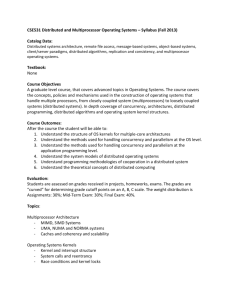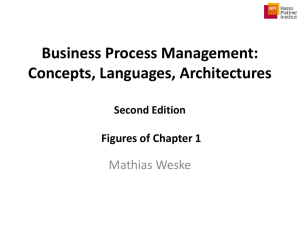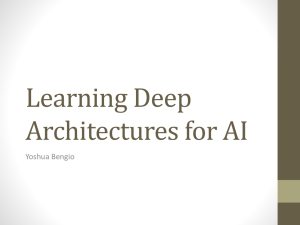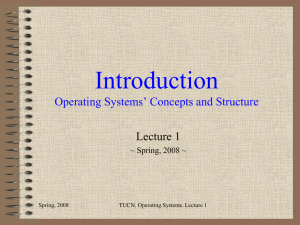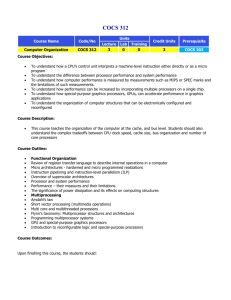AdvancedArchitecture..
advertisement
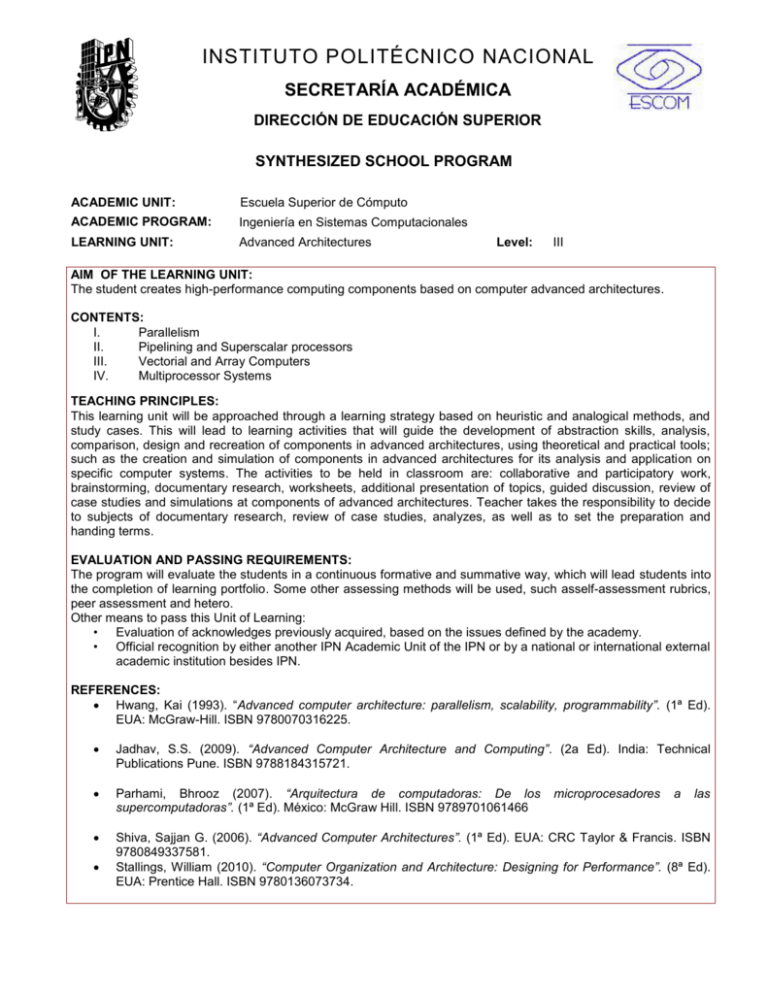
INSTITUTO POLITÉCNICO NACIONAL SECRETARÍA ACADÉMICA DIRECCIÓN DE EDUCACIÓN SUPERIOR SYNTHESIZED SCHOOL PROGRAM ACADEMIC UNIT: Escuela Superior de Cómputo ACADEMIC PROGRAM: Ingeniería en Sistemas Computacionales LEARNING UNIT: Advanced Architectures Level: III AIM OF THE LEARNING UNIT: The student creates high-performance computing components based on computer advanced architectures. CONTENTS: I. Parallelism II. Pipelining and Superscalar processors III. Vectorial and Array Computers IV. Multiprocessor Systems TEACHING PRINCIPLES: This learning unit will be approached through a learning strategy based on heuristic and analogical methods, and study cases. This will lead to learning activities that will guide the development of abstraction skills, analysis, comparison, design and recreation of components in advanced architectures, using theoretical and practical tools; such as the creation and simulation of components in advanced architectures for its analysis and application on specific computer systems. The activities to be held in classroom are: collaborative and participatory work, brainstorming, documentary research, worksheets, additional presentation of topics, guided discussion, review of case studies and simulations at components of advanced architectures. Teacher takes the responsibility to decide to subjects of documentary research, review of case studies, analyzes, as well as to set the preparation and handing terms. EVALUATION AND PASSING REQUIREMENTS: The program will evaluate the students in a continuous formative and summative way, which will lead students into the completion of learning portfolio. Some other assessing methods will be used, such asself-assessment rubrics, peer assessment and hetero. Other means to pass this Unit of Learning: • Evaluation of acknowledges previously acquired, based on the issues defined by the academy. • Official recognition by either another IPN Academic Unit of the IPN or by a national or international external academic institution besides IPN. REFERENCES: Hwang, Kai (1993). “Advanced computer architecture: parallelism, scalability, programmability”. (1ª Ed). EUA: McGraw-Hill. ISBN 9780070316225. Jadhav, S.S. (2009). “Advanced Computer Architecture and Computing”. (2a Ed). India: Technical Publications Pune. ISBN 9788184315721. Parhami, Bhrooz (2007). “Arquitectura de computadoras: De los supercomputadoras”. (1ª Ed). México: McGraw Hill. ISBN 9789701061466 Shiva, Sajjan G. (2006). “Advanced Computer Architectures”. (1ª Ed). EUA: CRC Taylor & Francis. ISBN 9780849337581. Stallings, William (2010). “Computer Organization and Architecture: Designing for Performance”. (8ª Ed). EUA: Prentice Hall. ISBN 9780136073734. microprocesadores a las INSTITUTO POLITÉCNICO NACIONAL SECRETARÍA ACADÉMICA DIRECCIÓN DE EDUCACIÓN SUPERIOR ACADEMIC UNIT: Escuela Superior de Cómputo. ACADEMIC PROGRAM: Ingeniería en Sistemas Computacionales LATERAL OUTPUT: Analista Programador de Sistemas de Información FORMATION AREA: Professional. MODALITY: Presence. LEARNING UNIT: Advanced Architectures TYPE OF LEARNING UNIT: Theorical - Practical, Optative. USE: August, 2011 LEVEL: III. CREDITS: 7.5 Tepic, 4.39 SATCA ACADEMIC AIM This learning unit contributes to the profile of the Engineer in Computer Systems to develop skills in the designing and building hardware components for advanced and efficient processing to create solutions for specific computer issues. It also provides tools, to obtain a creative judgment, collaborative and participatory work and assertive communication. This unit includes the units Discrete Mathematics, Computational Theory, Digital Design Fundamentals, Design of Digital Systems and Computer Architecture, as well as, ability to design hardware components in a hardware description language, abilities in documentary investigation and use of simulation tools. AIM OF THE LEARNING UNIT: The student creates high-performance computing components based on computer advanced architectures. CREDITS HOURS THEORETICAL CREDITS / WEEK: 3.0 PRACTICAL CREDITS / WEEK: 1.5 HOURS THEORETICAL / SEMESTER: 54 LEARNING UNIT DESIGNED BY: Academia de Sistemas Digitales REVISED BY: Dr. Flavio Arturo Sánchez Garfias Subdirector Académico HOURS PRACTICAL / SEMESTER: 27 APPROVED BY: HOURS AUTONOMOUS LEARNING: 54 CREDITS HOURS / SEMESTER: 81 AUTHORIZED BY: Comisión de Programas Académicos del Consejo General Consultivo del IPN. 2011 Ing. Apolinar Francisco Cruz Lázaro Presidente del CTCE. _______________________________ Ing. Rodrigo de Jesús Serrano Domínguez Secretario Técnico de la Comisión de Programas Académicos INSTITUTO POLITÉCNICO NACIONAL SECRETARÍA ACADÉMICA DIRECCIÓN DE EDUCACIÓN SUPERIOR LEARNING UNIT: PAGE: Advanced Architectures 3 OF OUT 9 THEMATIC UNIT: I TITLE: Parallelism UNIT OF COMPETENCE The student classifies parallel systems, based on computing paradigms and resources of parallelism. No. Teacher-Led Instruction HOURS CONTENTS T P Autonomous Learning HOURS T P 1.1 1.1.1 1.1.2 1.1.3 Computing Paradigms Serial Pipeline Parallel 0.5 1.0 1.2 1.2.1 1.2.2 Classification of parallel systems Flynn’s classification Others classifications 1.0 2.0 1.3 1.3.1 1.3.2 1.3.3 Parallelism Sources Control Parallelism Data Parallelism Flow Parallelism 1.5 2.0 1.4 1.4.1 1.4.2 1.4.3 Parallel System Throughput Quantities and performance measures Models of speed-up performance Models Based on Grain Size 1.0 1.5 3.0 3.0 4.0 1.5 8.0 3.0 Subtotals: REFERENCES KEY 5B, 2B, 1B, 3B Y 4C TEACHING PRINCIPLES Framing and team-work organization. This learning unit will be approached through a learning strategy based on heuristic and analogical methods, enabling the consolidation of the following learning techniques: worksheet, documentary research, led discussion, concept mapping, and team presentation of complementary issues and developed of a practical under a case study to evaluate the performance of a parallel system. Teacher takes the responsibility to decide to subjects of documentary research, review of case studies, analyzes and simulations performed as well as to set the preparation and handing terms. LEARNING EVALUATION Assessment Portfolio of Evidences: Worksheet Concept Map Team Presentation Report of Practical Rubric of Self-Evaluation Rubric of Co-Evaluation Evidence of Learning 15% 10% 15% 25% 3% 2% 30% INSTITUTO POLITÉCNICO NACIONAL SECRETARÍA ACADÉMICA DIRECCIÓN DE EDUCACIÓN SUPERIOR LEARNING UNIT: PAGE: Advanced Architectures 4 OF OUT 9 THEMATIC UNIT: II TITLE: Pipelining and superscalar processors UNIT OF COMPETENCE The student experiences techniques pipelining and superscalar processing, based on principles of pipelining design. No. CONTENTS Teacher-Led Instruction HOURS T P Autonomous Learning HOURS T REFERENCES KEY P 2.1 Principles and Pipelining Implementation. 1.0 1.5 2.0 3.0 6B, 2B, 5B, 1B Y 2.1.1 Linear Pipeline Processors. 3B 2.1.1.1 Asynchronous Model. 2.1.1.2 Synchronous Model. 2.2 Pipeline Processor Classification 1.0 2.0 2.2.1 According to Level of Processing. 2.2.2 According to Pipeline Configurations and Control Strategies 2.3 Arithmetic Pipeline Design. 1.0 2.0 2.3.1 Computer Arithmetic Principles. 1.5 3.0 2.3.2 Arithmetic Pipeline Stages 2.3.3 Multiply Pipeline Design. 2.4 Design Aspects of Instruction Pipeline. 1.0 2.0 2.4.1 Instruction Execution Phases. 2.4.2 Mechanisms for Instruction Pipelining. 2.4.3 Dynamic Instruction Scheduling. Branch Handling Techniques. 2.4.4 2.5 Superscalar Processors 1.5 2.0 2.5.1 Design Superscalar Pipelining. 2.5.2 Design Superpipelining. 2.5.3 Supersymmetry and design solutions. 2.6 Case Study: Pentium Processor 0.5 2.0 Subtotals: 6.0 3.0 12.0 6.0 TEACHING PRINCIPLES This learning unit will be approached through a learning strategy based on heuristic and analogical methods, enabling the consolidation of the following learning techniques: worksheet, documentary research, led discussion, concept mapping, team presentation of complementary issues and developed of practicals, comparing trough case studies techniques Intel Pentium Processor Pipeline. LEARNING EVALUATION Assessment Portfolio of Evidences: Worksheet 05% Concept Map 05% Comparison Chart 10% Team Presentation 05% Report of Practical 25% Case study report 15% Rubric of Self-Evaluation 3% Rubric of Co-Evaluation 2% Evidence of Learning 30% INSTITUTO POLITÉCNICO NACIONAL SECRETARÍA ACADÉMICA DIRECCIÓN DE EDUCACIÓN SUPERIOR LEARNING UNIT: PAGE: Advanced Architectures 5 OUT OF 9 THEMATIC UNIT: III TITLE: Vector and Array Computers UNIT OF COMPETENCE The student verifies the efficiency of vector and array architectures based on design principles and purposes of those architectures. No. Teacher-Led Instruction HOURS CONTENTS Autonomous Learning HOURS T P T P 3.1 3.1.1 3.1.2 3.1.3 3.1.4 3.1.5 Vector Processors SIMD, MIMD, VLIW, EPIC Basic Vector Processor Interlaced or Interleaved Memory Vector length and separation of elements Relative performance between vector and scalar 1.5 1.0 3.0 2.0 3.2 3.2.1 3.2.2 3.2.3 3.2.4 3.2.5 3.2.6 Array Processors Basic Organization Internal structure of a processing element Matrix Instructions SIMD Matrix Multiplication Associative Processors Associative Memories on Hardware 1.5 1.0 3.0 2.0 0.5 3.3 REFERENCES KEY 5B,2B,1B,3B,6B,7C 4C 1.0 Case Study: Intel Pentium 4, IBM Power4 and 1.0 2.0 ARM11 MPCore Subtotals: 4.0 2.5 8.0 5.0 TEACHING PRINCIPLES This learning unit will be approached through a learning strategy based on heuristic and analogical methods, enabling the consolidation of the following learning techniques: worksheet, documentary research, led discussion, concept mapping, team presentation of complementary issues and development of practicals, comparing trough case studies techniques Intel, IBM and ARM vector and array processors. LEARNING EVALUATION Assessment Portfolio of Evidences: Worksheet Concept Map Comparison Chart Team Presentation Report of Practical Case study report Rubric of Self-Evaluation Rubric of Co-Evaluation Evidence of Learning 5% 5% 15% 5% 20% 15% 3% 2% 30% INSTITUTO POLITÉCNICO NACIONAL SECRETARÍA ACADÉMICA DIRECCIÓN DE EDUCACIÓN SUPERIOR LEARNING UNIT: PAGE: Advanced Architectures 6 OUT OF 9 THEMATIC UNIT: IV TITLE: Multiprocessor Systems UNIT OF COMPETENCE The student simulates multiprocessor systems based on interconnection networks and parallel algorithms. No. Teacher-Led Instruction HOURS CONTENTS T P Autonomous Learning HOURS T 4.1 Multiprocessor system description (features, usability and benefits). 0.5 1.0 4.2 4.2.1 4.2.2 Memory configurations in a multiprocessor system. Shared memory multiprocessor systems. Distributed memory multiprocessor systems. 0.5 1.0 4.3 4.3.1 4.3.2 4.3.3 4.3.4 4.3.5 Interconnection networks Timeshare common channel. Bar Red Cross and multiport memory. Multistage networks. Mesh network. Hypercube network. 1.5 3.0 4.4 4.4.1 4.4.2 Parallel algorithms for multiprocessor systems. Synchronized parallel algorithms. Asynchronous parallel algorithms. 0.5 4.5 Case study: Multicore Intel and IBM Cell. 1.0 0.5 0.5 REFERENCES KEY P 5B, 2B, 1B y3B 1.0 1.0 1.0 0.5 0.5 1.0 1.0 2.0 Subtotals: 4.0 2.0 8.0 4.0 TEACHING PRINCIPLES This unit will be addressed from the strategy of case-based learning and heuristic methods and analog, allowing the consolidation of the following learning techniques: worksheet, documentary research, led discussion, concept mapping, comparison chart, exhibition equipment complementary issues, work experience, simulations of parallel algorithms and case studies of multiprocessor systems from Intel and the IBM Cell. LEARNING EVALUATION Assessment Portfolio of Evidences: Worksheet Concept Map Comparison Chart Team Presentation Report of Practical Case study report Rubric of Self-Evaluation Rubric of Co-Evaluation Simulations 5% 5% 10% 5% 10% 15% 3% 2% 45% INSTITUTO POLITÉCNICO NACIONAL SECRETARÍA ACADÉMICA DIRECCIÓN DE EDUCACIÓN SUPERIOR LEARNING UNIT: PAGE: Advanced Architectures 7 OUT OF 9 RECORD OF PRACTICALS PRACTICAL No. NAME OF THE PRACTICAL THEMATIC UNITS DURATION ACCOMPLISHMENT LOCATION 1 Simulation and performance analysis of parallel algorithms. I 4.5 Computer lab 2 VLSI module linear pipeline. II 4.5 Digital electronics lab. 3 VLSI efficient multiplier. II 4.5 Digital electronics lab. 4 Evaluation of polynomials in VLSI III 3.0 Digital electronics lab. 5 Matrix multiplication in VLSI III 3.0 Digital electronics lab. 6 Implementation of VLSI associative memories III 1.5 Digital electronics lab. 7 Simulation of multiprocessors in a network of cross bar IV 1.5 Computer lab 8 Multiprocessor simulation mesh IV 1.5 Computer lab 9 Simulation of a synchronized parallel algorithm. IV 1.5 Computer lab 10 Simulation of an asynchronous parallel algorithm. IV 1.5 Computer lab TOTAL OF HOURS 27.0 EVALUATION AND VALIDATION: Practicals are considered a prerequisite for this learning unit credit. Practicals contribute 25% of the grade of thematic unit I and II. Practicals contribute 20% of the grade of thematic unit III. Practicals contribute 10% of the grade of thematic unit IV. Tests desk will be evaluated, the simulations and the written report of the results of experiments or simulations as appropriate. INSTITUTO POLITÉCNICO NACIONAL SECRETARÍA ACADÉMICA DIRECCIÓN DE EDUCACIÓN SUPERIOR LEARNING UNIT: PAGE: Advanced Architectures PERÍOD 1 UNIT I, II Continuous assessment Written learning evidence EVALUATION TERMS 70% 30% 2 III Continuous assessment Written learning evidence 70% 30% 3 IV Continuous assessment 100% 8 OUT OF 9 Unit I and II 30% of the total of the final evaluation. Unit III 30% of the total of the final evaluation. Unit IV 40% of the total of the final evaluation. Other means to pass this Unit of Learning: • Official recognition by either another IPN Academic Unit of the IPN or by a national or international external academic institution besides IPN. If accredited by Special Assessment or a certificate of proficiency, this will be based on guidelines established by the academy on a previous meeting for this purpose. KEY 1 B X 2 X 3 X 4 5 6 7 C REFERENCES Hwang, Kai (1993). “Advanced computer architecture: parallelism, scalability, programmability”. (1ª Ed). EUA: McGraw-Hill. ISBN 9780070316225 . Jadhav, S.S. (2009). “Advanced Computer Architecture and Computing”. (2a Ed). India: Technical Publications Pune. ISBN 9788184315721. Parhami, Bhrooz (2007). “Arquitectura de computadoras: De los microprocesadores a las supercomputadoras”. (1ª Ed). México: McGraw Hill. ISBN 9789701061466. X Patterson, David A. and Hennessy, John L. (2008). “Computer Organization and Design: The Hardware/Software Interface. (4ª Ed). Canada: The Morgan Kaufmann. ISBN 9780123744937 X Shiva, Sajjan G. (2006). “Advanced Computer Architectures”. (1ª Ed). EUA: CRC Taylor & Francis. ISBN 9780849337581. X Stallings, William (2010). “Computer Organization and Architecture: Designing for Performance”. (8ª Ed). EUA: Prentice Hall. 9780136073734 X ISBN Vai, M. Michael. (2000). “VLSI design”. (1ª Ed). EUA: CRC Press. ISBN 9780849318764 INSTITUTO POLITÉCNICO NACIONAL SECRETARÍA ACADÉMICA DIRECCIÓN DE EDUCACIÓN SUPERIOR TEACHER EDUCATIONAL PROFILE PER LEARNING UNIT 1. GENERAL INFORMATION ACADEMIC UNIT: Escuela Superior de Cómputo. ACADEMIC PROGRAM: FORMATION AREA: ACADEMY: LEVEL: Ingeniería en Sistemas Computacionales Institutional Basic Scientific Professional III Terminal and Integration LEARNING UNIT: Advanced Architectures Sistemas Digitales SPECIALTY AND ACADEMIC REQUIRED LEVEL: Master Degree or Doctor in Computer Science. 1. AIM OF THE LEARNING UNIT: The student creates high-performance computing components based on computer advanced architectures. 2. PROFESSOR EDUCATIONAL PROFILE: KNOWLEDGE Sequential and combinational logic circuits. VLSI Design. Hardware description. FPGA´s Computer Architecture. Parallel Architectures. MEI. English language PROFESSIONAL EXPERIENCE One-year-experience in VSLI design. One-year-experience in FPGA´s development. Two-years-experience in handling groups and collaborative work. One-year-experience as a Professor of Higher Education. DESIGNED BY M. en C. Edgardo Adrián Franco Martínez Dr. Consuelo Varinia García Mendoza M. en C. Daniel Cruz García ABILITIES APTITUDES Analysis and synthesis. Leadership. Decision making. Conflict Resolution. Group management. Verbal fluency of ideas. Teaching Skills. ELABORATED REVISED BY Dr. Flavio Arturo Sánchez Garfias Subdirector Académico Responsible. Honest. Respectful. Tolerant. Assertive. Collaborative. Participative. AUTHORIZED REVIEWED BY Ing. Apolinar Francisco Cruz Lázaro Director Date: 2011
